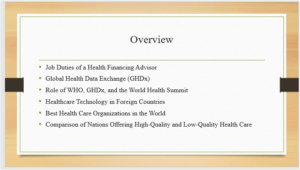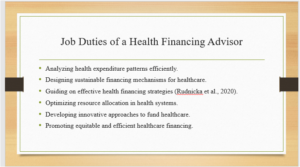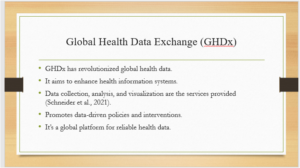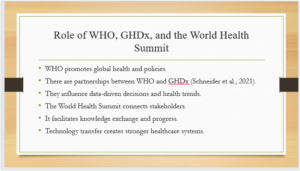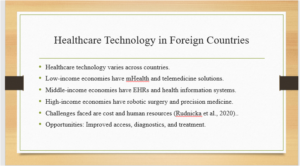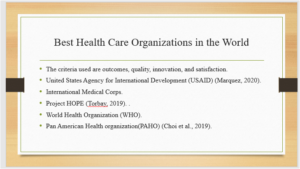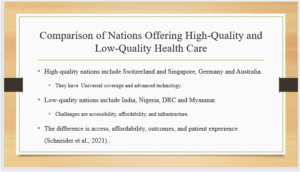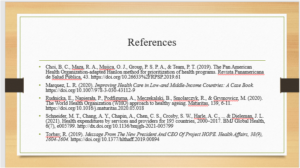Hello and welcome to my presentation on what I learned at the recent World Health Summit.
This presentation will cover a wide range of topics related to global health and healthcare systems. We will begin by discussing the job duties of a Health Financing Advisor, highlighting their crucial role in designing sustainable health financing strategies. Next, we will delve into the Global Health Data Exchange (GHDx) and its significance in collecting, analyzing, and sharing health data worldwide. We will explore the roles of the World Health Organization (WHO), GHDx, and the World Health Summit in promoting global health and driving progress in the field. Additionally, we will examine healthcare technology in foreign countries, focusing on the impact of innovative solutions on improving healthcare delivery. Finally, we will explore the best healthcare organizations in the world, highlighting their clinical expertise, research contributions, and patient-centered care models. Lastly, we will compare nations offering high-quality and low-quality healthcare, discussing key factors and challenges.
A Health Financing Advisor at the World Health Organization (WHO) plays a crucial role in analyzing health expenditure patterns, designing financing mechanisms, and providing guidance on sustainable health financing strategies (Rudnicka et al., 2020). This role involves assessing how resources are allocated and utilized within health systems, with the aim of improving overall healthcare financing efficiency and effectiveness. Analyzing health expenditure patterns involves studying and evaluating the distribution and utilization of funds within the health sector. It also involves identifying areas of inefficiency and determining where resources can be allocated more effectively. By examining these patterns, advisors can identify gaps in funding and recommend strategies to optimize resource allocation. Subsequently, designing financing mechanisms is developing innovative approaches to fund healthcare services. For instance, health insurance schemes, social health protection systems, and public-private partnerships. These mechanisms aim to ensure everyone has access to essential healthcare services without financial hardship. Providing guidance on sustainable health financing strategies involves working closely with governments, policymakers, and other stakeholders to develop long-term financing plans. This ensures that there is equitable access to quality healthcare. These strategies may involve exploring different revenue sources, advocating for increased health investments, and promoting efficient use of resources.
GHDx is an essential platform that facilitates the collection, analysis, visualization, and sharing of global health data. It significantly impacts improving health information systems and supporting evidence-based decision-making worldwide. Its history and development are traced back to the need for standardized data and evidence-based decision-making in the field of global health. Over time, it has evolved into a comprehensive platform that plays a pivotal role in enhancing global health data management. The formation of GHDx was driven by several reasons. One of the main motivations was the recognition of the importance of standardized and reliable data to inform health policies and interventions. GHDx was established to address this need by promoting data collection, analysis, and dissemination in a consistent and transparent manner (Schneider et al., 2021). The objectives of GHDx are multifaceted. Firstly, it aims to improve health information systems by providing a central hub for reliable and comprehensive health data. Secondly, GHDx seeks to support health research by making relevant datasets and tools easily accessible to researchers worldwide. GHDx provides a wide range of services globally. These include collecting data from various sources, analyzing it to generate insights and trends, and visualizing the data in user-friendly formats. It also shares the information with stakeholders (Schneider et al., 2021). By doing so, GHDx contributes to the development of data-driven policies and interventions that have the potential to improve global health outcomes.
The WHO, GHDx, and the World Health Summit play critical roles in advancing global health initiatives. They also facilitate collaboration in the healthcare sector. WHO actively engages in promoting global health by shaping policies, coordinating international efforts, and advocating for health equity. Through collaboration with GHDx, WHO leverages the platform’s data and analytical capabilities (Schneider et al., 2021). It is, therefore, able to support evidence-based decision-making, monitor health trends, and drive innovation in health financing. The partnership between these entities strengthens the availability and utilization of reliable health data for informed decision-making at various levels. The World Health Summit serves as a significant global health conference. It brings together stakeholders from academia, politics, and civil society. It plays a pivotal role in convening experts, facilitating knowledge exchange, and driving progress in global health. Additionally, WHO and GHDx contribute to the provision of new technologies to foreign countries. They support the adoption and transfer of innovative healthcare solutions. By promoting the dissemination and implementation of these technologies, they contribute to strengthening healthcare systems worldwide. These entities work collaboratively to improve global health outcomes, address health disparities, and foster innovation in healthcare delivery.
Healthcare technology varies across countries, with low-income, middle-income, and high-income economies each employing different solutions to enhance healthcare delivery. In low-income economies, countries such as Uganda and Bangladesh have implemented technologies like mobile health (mHealth) applications and telemedicine to overcome limited access to healthcare professionals and facilities. These technologies enable remote consultations, health education, and disease monitoring. In middle-income economies like Brazil and India, electronic health records (EHRs) and health information systems have been adopted to improve diagnostics and patient management. These systems facilitate the integration of health data, enhancing coordination and efficiency in healthcare delivery. High-income economies like the United States and Germany have advanced medical technologies, including robotic-assisted surgery, precision medicine, and artificial intelligence (AI) applications for diagnostics. These technologies optimize treatment outcomes and enable personalized care. Despite the opportunities, adopting healthcare technology poses challenges in different contexts. Low-income countries face limited financial resources and inadequate infrastructure, hindering widespread implementation. Middle-income countries encounter resource constraints and the need to balance costs with benefits. High-income countries face challenges in integrating complex technologies into existing healthcare systems. However, these challenges also present opportunities (Rudnicka et al., 2020). Healthcare technology can help overcome geographical barriers, enhance healthcare access in underserved areas, improve diagnosis accuracy, and facilitate evidence-based decision-making. By addressing the challenges and harnessing the potential of healthcare technology, countries can strive towards equitable and high-quality healthcare for all.
Identifying the best healthcare organizations involves evaluating several criteria that assess patient outcomes, quality indicators, innovation, and patient satisfaction. These factors help determine the organizations that excel in providing high-quality care and achieving positive health outcomes.
The five chosen organizations stand out for their exceptional services and achievements. USAID is renowned for its cutting-edge research and expertise in specialized treatments (Marquez, 2020). International Medical Corps is recognized for its comprehensive and patient-centered approach. It provides holistic care across various medical disciplines. Project HOPE has earned acclaim for its innovative use of technology in healthcare delivery, improving efficiency and accessibility (Torbay, 2019). The WHO has a strong focus on preventive care, implementing programs that promote healthy lifestyles and disease prevention. PAHO has gained recognition for its exceptional patient satisfaction rates and personalized care models (Choi et al., 2019). These organizations are considered the best due to several factors. They possess a wealth of clinical expertise, attracting top talent and offering the highest quality of care. Their research contributions drive advancements in medical knowledge and treatment methodologies. Patient-centered care models prioritize the individual needs and preferences of patients. Furthermore, these organizations are committed to continuous improvement, regularly adopting new practices and technologies to enhance healthcare outcomes.
Comparing nations based on the quality of their healthcare systems provides insights into the strengths, weaknesses, and areas for improvement. Among nations known for their high-quality healthcare, Switzerland stands out for its universal coverage, comprehensive services, and high patient satisfaction. Singapore excels in healthcare outcomes, efficient healthcare financing, and strong primary care. Germany boasts a well-developed healthcare infrastructure, advanced medical technology, and a focus on preventive care. Australia is recognized for its accessible healthcare system, effective health promotion, and excellent health outcomes. In contrast, nations facing challenges in delivering quality healthcare include India, where accessibility and affordability remain significant issues. Nigeria struggles with inadequate healthcare infrastructure, limited access to quality care, and resource constraints. The Democratic Republic of Congo faces similar challenges, compounded by political instability and healthcare workforce shortages. Myanmar also encounters challenges related to infrastructure, resources, and equity in healthcare delivery. These low-quality healthcare nations highlight the need for improved access, infrastructure, and resource allocation. Major differences between the two groups include disparities in healthcare access, affordability, health outcomes, and patient experience. High-quality healthcare nations prioritize universal coverage, preventive care, and strong primary care. Low-quality healthcare nations need to address barriers to access, invest in infrastructure, and improve healthcare delivery systems to enhance the overall quality of care for their populations (Schneider et al., 2021).
The presentation covered several key points related to health financing, data exchange, international organizations, technology, and healthcare quality comparison. Health financing advisors play a crucial role in analyzing health expenditure patterns, designing financing mechanisms, and providing guidance on sustainable strategies. The Global Health Data Exchange (GHDx) was highlighted as a platform for collecting, analyzing, visualizing, and sharing health data to support evidence-based decision-making. The involvement of organizations like WHO, GHDx, and the World Health Summit was emphasized, underscoring their roles in promoting global health, facilitating knowledge exchange, and driving progress in the field. The impact of technology on healthcare in foreign countries was discussed, particularly in terms of providing innovative solutions and improving access to quality care. The presentation also touched upon the comparison of nations offering high-quality and low-quality healthcare, emphasizing the importance of collaboration and technological advancements in addressing challenges and enhancing healthcare delivery. Furthermore, the best healthcare organizations were mentioned, highlighting their clinical expertise, research contributions, patient-centered care models, and commitment to continuous improvement. Overall, the presentation emphasized the significance of collaboration, technological advancements, and data-driven approaches in improving healthcare outcomes and ensuring equitable access to quality care.
ORDER A PLAGIARISM-FREE PAPER HERE
We’ll write everything from scratch
Question
Description
Key Assignment Draft
Imagine you are a Program Manager or Technical Analyst, working for the World Health Organization (WHO) or a Non-governmental Organization (NGO). You have been asked to put together a PowerPoint presentation of 10-12 slides, not including title or reference slides, about what you learned at the recent World Health Summit. Each slide with content should also include 200-word Speaker Notes. Be sure to include the following information in your presentation:

Global Health Systems Task
Explain your job duties.
Describe the history and development of the Global Health Data Exchange (GHDx), and explain why it was formed. Include the types of services it provides around the world.
Explain how the WHO, GHDx, and the World Health Summit are involved in world health, including information about how new technology is provided for foreign countries.
Provide and describe the types of healthcare technology available in foreign countries. This can include low-income, middle-income, and high-income economies.
Select 5 of the best healthcare organizations in the world, and summarize the services they provide. Explain why these are considered the best health care organizations in the world.
A table outlines significant differences among the 4 nations offering the best health care as compared to those that provide low-quality health care.
Be sure to support your information by citing at least 2 scholarly references using APA format.
Please submit your assignment.PowerPoint presentation please send the price in an email


